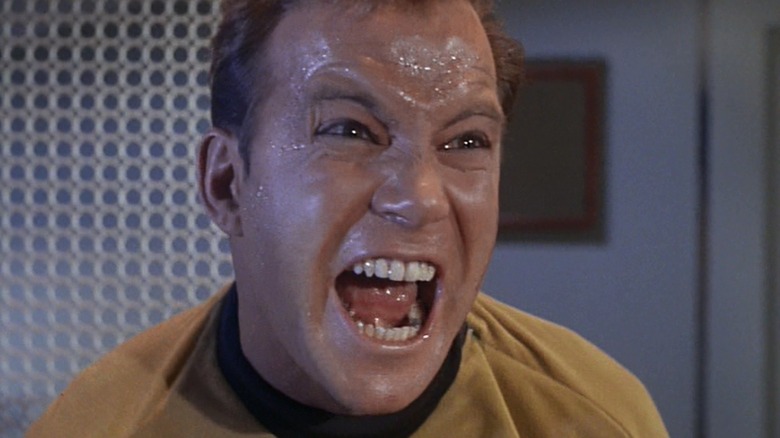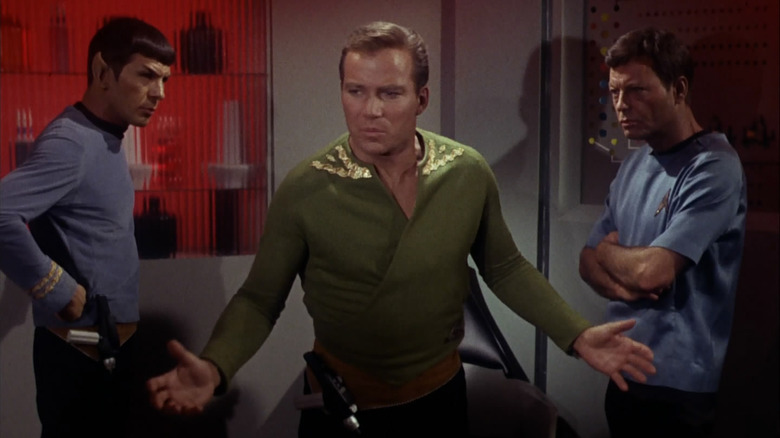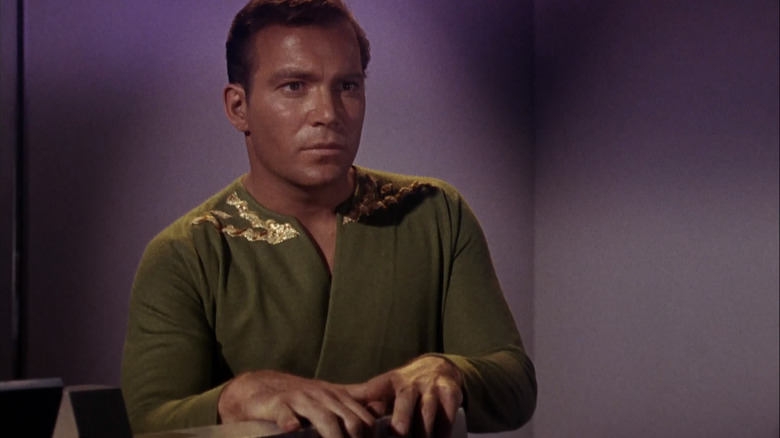The Native American Myth That Inspired Star Trek's The Enemy Within
On the 1966 "Star Trek" episode "The Enemy Within," Captain Kirk (played by one-time /Film writer William Shatner) beams up from a geological research mission covered in a rare magnetic dust. The dust causes a glitch in the Enterprise's transporter, resulting in Kirk bifurcating into two separate beings. The first Kirk to beam up contains all of Kirk's intelligence and rationality, while the second Kirk — arriving a few moments later — contains all of his aggression or anger. With a "good" captain and an "evil" captain on board the Enterprise, mayhem ensues.
By the end of the episode, both Kirks must face off, and then, naturally, reunite. Spock (Leonard Nimoy) points out that Kirk cannot be an effective captain without his irrational rage and aggression; as a gentle person, he's not complete. The "evil" Kirk is a madman but he's also a vital part of Kirk's core being. "The Enemy Within" points out that we all contain an animalistic id that we must live with; our anger and aggression cannot be so easily shunted from our bodies. This addresses the way certain philosophies view evil. From one perspective, good and evil are separate, warring forces, with one side necessarily having to triumph over the other. From another, good and evil are two parts of the same being. They are not separate. The yin and the yang. The duality of man.
The episode was written by sci-fi luminary Richard Matheson, who also wrote one of the very best episodes of "The Twilight Zone" (among many other things). He once told the UK outlet The Times that "The Enemy Within" was openly inspired by Robert Louis Stevenson's "The Strange Case of Dr. Jekyll and Mr. Hyde." In Mark A. Altman's and Edward Geoss' book "Captains' Logs: The Unauthorized Complete Trek Voyages," however, episode director Leo Penn added that he borrowed from certain Native American myths to address ideas of duality.
The stories of Hiawatha
"Captain's Logs" tracked down an interview Penn gave with Starlog magazine, and quoted him as saying:
"Within certain aspects of American Indian culture, they surmise that evil possesses more energy than good, and Indians believe if they could get to the evil one and comb the snakes out of his hair, he would be cleansed and be able to use that energy for good. One is constantly interested in the struggle between good and evil ... In every human being there's good and bad. Hopefully the good is reachable. There are some leaders who bring out the best in people, and Captain Kirk was certainly such a person."
Penn's comment is an allusion to the myth of Hiawatha. Hiawatha was a real person, credited for co-founding the Iroquois nation, and said to be the leader of the Onondaga nation or perhaps the Mohawk nation, but he is also the hero of many legendary epic tales. The mythic version of Hiawatha was said to have been discovered living in a remote hut by Dekanawidah, the founder of the Iroquois Confederacy. This was a wild Hiawatha who viciously ate human flesh. The story goes that Dekanawidah was so wise and peaceful that Hiawatha was humbled in his presence, received a new peaceful philosophy, and immediately abandoned his early, cannibalistic ways. Hiawatha was thereafter a wise sage and a spreader of peace.
Dekanawidah then sent the now-reformed Hiawatha to the Onondaga people to confront their chief, a wicked tyrant named Tadodaho. This Tadodaho was so evil that he had turned into a literal monster; his hair and his fingers were made of snakes. Hiawatha then combed the snakes out of his hair, a symbol of his redemption. "Hiawatha," literally translated, means "he who combs."
Good vs. Evil
Many modern students might have first learned Hiawatha's name from Henry Wadsworth Longfellow's celebrated 1855 poem "The Song of Hiawatha," although Longfellow notoriously cribbed details of Native American society from wildly inaccurate ethnographical "studies" conducted by European scientists who weren't entirely devoted to accuracy. It's also worth noting that "The Song of Hiawatha" is structured like a European epic, and doesn't resemble Native American storytelling traditions in the slightest.
"The Enemy Within," meanwhile, retains the classic conflicts over good vs. evil. Can one comb the snakes from their hair, purify themselves, and be "good" in perpetuity? Or must one, as Matheson wrote, retain their "evil" side in order to be a more complete human being? It's interesting that the writer of "The Enemy Within" and its director seemed to fall on opposite sides of the debate.
A Medium article delved into Iroquois myths even more deeply, pointing out that combing snakes out of one's hair extends all the way back into the nation's creation myths. According to the myth, a pair of twins were born in a realm of evil and pain, similar to popular images of the Christian Hell. One twin — resolute and good — aimed to improve the dark world, hoping to change it for the better. The other twin — wicked and lazy — wanted the evil world to stay the way it was. The good twin is commonly compared to God and the wicked one to Satan, but one can also see a parable of complacency vs. progress. There are good and wicked people on the planet. The good, then, must inspire the wicked with their righteousness.
At the end of "The Enemy Within," the two Kirks are reunited using the Enterprise's transporter, resulting in the good and the evil working together again. It's all very inspiring — and far more interesting than merely using Robert Louis Stevenson as a jumping-off point.


